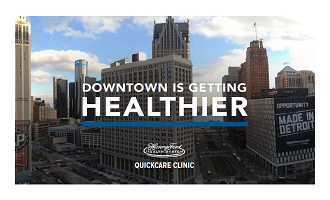PATIENT EXPERIENCE
Henry Ford Health System Works to Attract Consumers With ‘Radical Convenience’
For more than a decade, Henry Ford Health System has been working to provide what it calls “radical convenience” to its patients, with care available at the click of a button or swipe of a smartphone. But in 2019’s rapidly evolving world of health care consumerism, leaders believe that mantra is no longer enough, and they’re aggressively pursuing new ways to entice potential patients.
The hospital system has encouraged consumers to “call, click or come in” when in need of care. And it’s backed up that promise by offering a 24/7 medical advice line, virtual visits and online reservations via smartphone, and a dozen walk-in clinics. High consumer expectations and new entrants into the health care market mean Henry Ford must dig deeper to evolve its strategy and discover “Radical Convenience 2.0.”
“As part of an organization that was founded by [auto industry pioneer] Henry Ford, our leadership always pushes the envelope and allows us the opportunity to investigate and, in certain cases, disrupt the market,” said Ara Telbelian, director of marketing and brand management for the five-hospital system.
 Most recently, leaders have disrupted the traditional retail health market in Detroit by establishing a new QuickCare Clinic. The “health care boutique” is located in the heart of the central business district and is geared toward busy Gen Xers and millennials.
Most recently, leaders have disrupted the traditional retail health market in Detroit by establishing a new QuickCare Clinic. The “health care boutique” is located in the heart of the central business district and is geared toward busy Gen Xers and millennials.
Henry Ford worked in tandem with Detroit-based Quicken Loans and other nearby employers to design the new clinic to meet workers’ needs. That included interviewing nearly 800 company team members to gain key insights about how they want to receive on-demand care — such as the hours, how much they’re willing to pay out of pocket, and how far they’d be willing to travel to get there.
One of the main thrusts was establishing a quick and easy clinic that’s just 15 minutes away from a young person’s desk and wouldn’t disrupt their day or drain worker productivity.
“Quicken Loans and other businesses saw this opportunity as a value for them because, before the clinic was open, if their employees needed to be seen by a doctor, they had to leave work and drive out into the suburbs,” said Telbelian. “Whether they come back or not would be up to the employees and the providers. So, that meant hours of lost productivity and time away from their jobs.”
Feedback from the interviews with company workers led to Henry Ford establishing its 2,000-square-foot QuickCare Clinic in 2015. The original iteration operated from 7:30 a.m. to 6 p.m. Monday through Friday with treatment for more than 40 low-acuity ailments — including vaccinations, medical tests, non-narcotic prescriptions and minor injuries. Telemedicine services and alternative treatments, such as acupuncture and massages, were also available.
The first clinic was staffed by a nurse practitioner and concierge, with walk-ins welcome. QuickCare accepts credit cards and the same insurance plans as the Henry Ford Medical Group, but no cash. It also offers a retail pricing menu for routine types of care and testing.
Henry Ford constructed the original location along Woodward Avenue in a building that had been empty for 30 years. It tagged the marketing campaign for the new service as “Downtown Is Getting Healthier” — a double entendre referring to both revitalizing Detroit’s central business district and the well-being of young professionals who work there. At launch, the first space also incorporated four exam rooms, a limited waiting area built to look like a living room, and retail space for vitamins or other related products.
 Telbelian said Henry Ford launched a promotional blitz to attract young people to the clinic — emphasizing that it’s “less than 15 minutes from their desks.” They used digital advertising, social media, search-engine marketing, billboards and posters. They deployed guerilla marketing tactics, too, including power-washing sidewalks with messages, wrapping the Detroit People Mover and more. The health system also partnered with a radio station to set up a community event at the park a few blocks from the clinic to generate further buzz.
Telbelian said Henry Ford launched a promotional blitz to attract young people to the clinic — emphasizing that it’s “less than 15 minutes from their desks.” They used digital advertising, social media, search-engine marketing, billboards and posters. They deployed guerilla marketing tactics, too, including power-washing sidewalks with messages, wrapping the Detroit People Mover and more. The health system also partnered with a radio station to set up a community event at the park a few blocks from the clinic to generate further buzz.
Millennials and Gen Xers listened, with the clinic seeing more than 1,800 visits in the first full year, and 2,700-plus in 2017. That swelled to about 4,000 last year, leaving QuickCare bursting at the seams. During the 12 months following the August 2015 opening, traffic increased by 50%.
“We became very successful, too successful in some ways,” Telbelian said. “That forced us to retool the clinic.” In fall 2017, leaders relocated QuickCare to a 6,000-square-foot building about two blocks away that could better accommodate their needs. They shortened the morning hours slightly, realizing there wasn’t demand early in the day. And they added further clinical support staff to better serve young professionals, including radiology, a primary care physician and a nurse midwife for general obstetrics and gynecology care.
Like any other primary care provider, Telbelian said QuickCare only makes a few hundred dollars in billable revenue from the low-acuity services offered, but Henry Ford sees it as an investment in getting more young people into the system. He noted that about 28% of individuals under age 35 do not have a primary care doctor.
“It’s really an entry point to the rest of the system. As a stand alone, is it profitable? No, but we are looking at driving patient volumes to the health system’s entire continuum of care,” he said.
This article features an interview:
Ara Telbelian
Director of Marketing and Brand Management
Henry Ford Health System
Detroit, Michigan


